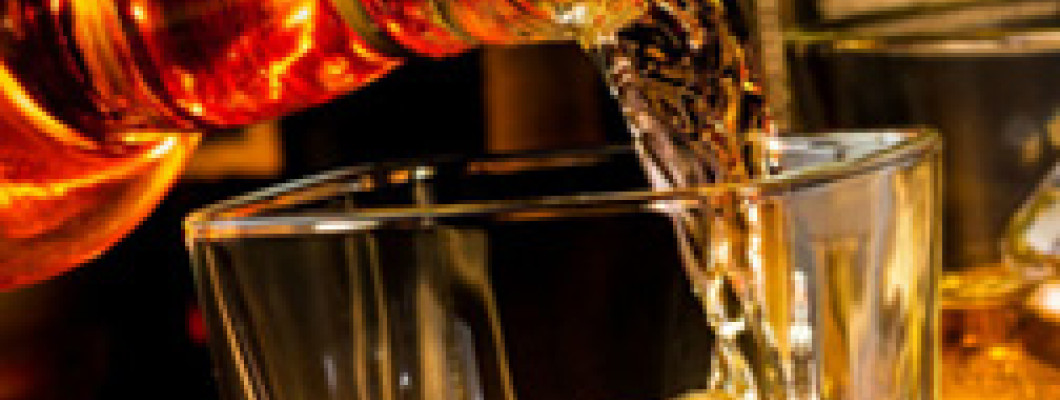
Table of Contents:
Ever wonder how a simple grain becomes the amber liquid in your glass? Did you know some people call whiskey “the water of life”? Perhaps you wonder why some people call it whiskey while others refer to it as whisky. Or, what is whiskey's origin? So to answer these questions, let's embark on the journey to unveil the history of whiskey and talk more about how lowly grains become a complex and flavorful spirit, the key processes involved in it, and what makes it come in different styles.
Whisky vs. Whiskey: Metamorphosis of its Name
Although whiskey's origins are a bit murky, it likely emerged in Scotland or Ireland. The term "Uisge beatha" in Gaelic, the Celtic language spoken in Scotland and Ireland, which literally translates to "water of life," hints at its Celtic roots and also reflects the early perception of distilled spirits as having medicinal properties, which is how whiskey earned its nickname.
Over time, English adopted and transformed this term, resulting in changes in pronunciation and spelling. Eventually, in the 18th century, the spelling settled on either "whisky" used by Scotland or "whiskey" used in Ireland, reflecting regional variations. Whiskey production, as well as its rich tapestries of history, make it a highly sought-after spirit. Now that we have familiarized ourselves with the history, let's dive deeper into uncovering the steps involved in making whiskey.
The Essence of Whiskey: Unveiling the Steps in Making Whiskey
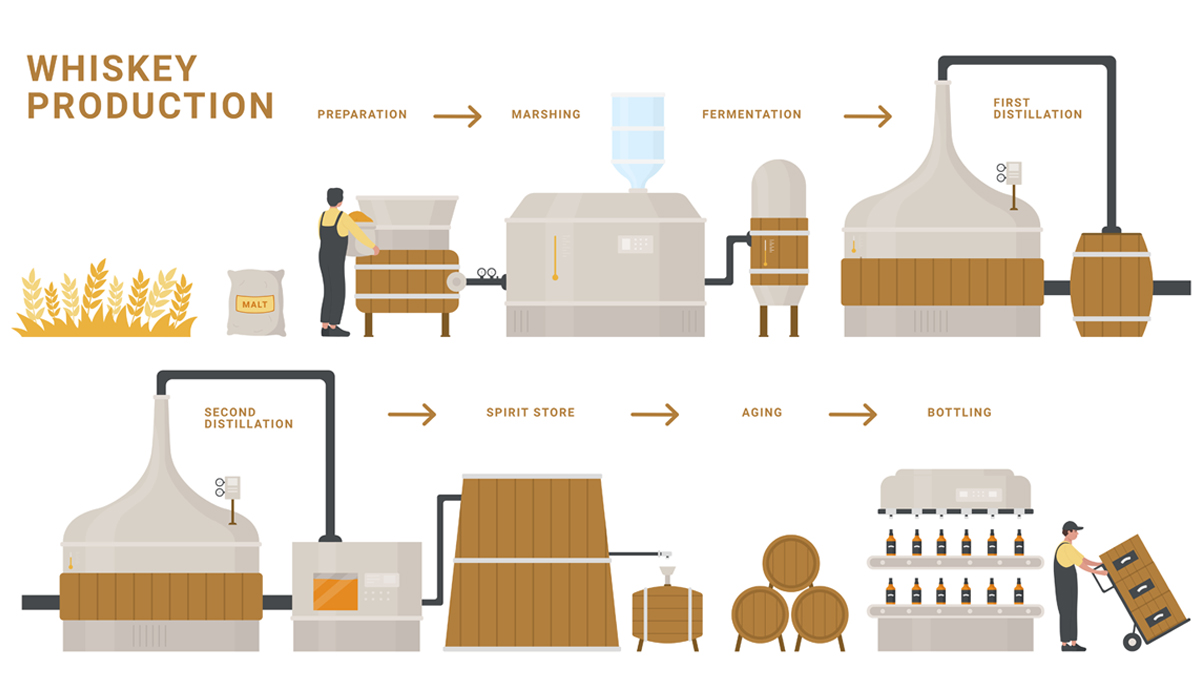
Traditional heredity creates whiskey with charm and alchemy, and here, we'll reveal the secrets behind the steps in making spirits the traditional way. The basic core ingredients for every whiskey are grain, water, and yeast. So let's see how whiskey is made and uncover the steps in making whiskey.
1. Malting: Core Ingredients to Malt
The steps in making whiskey begin with malting, the process of steeping, germinating, and drying grain to convert it into malt. Enzymes present in the sprouting grain convert starch into sugars. Barley is the most commonly used grain in the production of most whiskies. But we can also use different blends of grains like corn, rye, and wheat to give the spirit a unique character.
So to accomplish this, we steep high-quality barley in water and then spread it on malting floors for germination. To avoid heat accumulation, continue turning it frequently. After 6–7 days of germination, we transfer the green malt or barley to a kiln for drying to stop the germination process. We maintain the temperature below 70 °C to protect the enzymes. We can add peat to the kiln's fire as 'phenols' transfer from the peat, giving it a smoky flavor.
2. Mashing: Grains to Grit
The transformation begins as the grains grind into a coarse meal. The mash tun then soaks the coarse meal in hot water. Water is yet another important ingredient because of its mineral composition, which can affect the overall result. We add it in three stages, increasing its temperature at each stage from around 67 °C to nearly boiling point. This, in turn, breaks down the starches within the grain into fermentable sugars in a sweet liquid form called wort. We process the spent grains, known as "draff," into cattle feed.
3. Fermentation: The Birthplace of Alcohol
Did you know that whisky starts life as beer? So, we chill the sweet liquid gold, known as "wort or mash," to 20 °C and then transfer it into fermentation tanks, where we introduce yeast. The yeast consumes the sugars in the wort, transforming them into low-alcohol beer or base beer, carbon dioxide, and small amounts of other compounds known as congeners, all of which enhance the whisky's flavor. People often refer to base beer as "wash."
4. Distillation: The Heart of the Process
In a still, the distillation process separates the alcohol from the rest. The stills receive the low-alcohol beer for further processing. The still is heated to just below the boiling point of water, at which point the alcohol and other compounds start to vaporize and flow over the neck of the still into either a condenser or a worm, which is a large copper coil that has been immersed in cold running water so that the vapors are condensed into a liquid. Copper is often the material of choice for a still because of its ability to remove unwanted flavor and aroma components. The still's shape and number of distillations may vary depending on the type of whisky.
Here's a fun fact: early whisky drinkers would have consumed it directly from the still, at around 70% alcohol. Only in the 16th century did researchers discover that storing the spirit in oak casks allowed the flavor to mature, evolve, and mellow into something far more sophisticated and complex.
5. Aging: The Art of Maturation
People often refer to the fresh distillery whiskey as a "white dog" or "new make." Over a period of time, this new spirit embarks on a journey through wooden casks. Sometimes, over a period of years or even decades, the whiskey undergoes a series of reactions with the wood of wooden casks, which result in its classic color, depth of flavor, and complexity, giving whiskey its unique characteristics. These casks play an important role in defining the final character of whiskey.
Distilleries mostly use traditional charred white oak casks, but nowadays they have begun to experiment with other kinds of casks to develop unique flavor profiles.
6. The Final Act: Bottling
Once the whiskey reaches its full maturity, we filter it and dilute it with water to achieve the desired alcohol content. Finally, we package and bottle the whiskey for its journey to your glass. However, that's not always a direct route, as each whiskey differs, with promises of a palette of flavors and aromas to discover. The distiller may occasionally blend whiskey from different batches or barrels to give it a unique flavor character. Around the world, the choice of grain, whether to malt or not, still types, cask selection, and time of maturation all influence the process of making whiskey.
And after all that, now it’s time for the fun part—drinking!
Different Types of Whiskey
The whiskey world is a maze of various tastes and different types of whiskey, each distinguished on the basis of their origins. To classify, the five major whiskey styles are from Scotland, Ireland, the USA, Canada, and lastly, and Japan.
Each region standardizes and advocates whiskey making according to its own regulations, from grains to barrel type, aging span, and more. For instance, Scotland's Scotch is mostly based on malt in comparison to Canadian whiskey, which is a blend of multiple grains. Additionally, America's classic whiskey styles, Bourbon and Tennessee, abide by a strong corn base but have differing aging techniques, with Tennessee going under charcoal filtration.
Whiskey Varieties: A Quick Look at Global Styles
Whiskey offers an incredible range of flavors spread across the spectrum. Here are some of the more common varieties, based on origin and grain bill.
| Feature | Scotch Whisky | Irish Whiskey | Bourbon | Tennessee Whiskey | Canadian Whisky | Japanese Whisky |
|---|---|---|---|---|---|---|
| Origin | Scotland | Ireland | USA | USA | Canada | Japan |
| Production Method | Single malt or blended | Triple-distilled | Aged in new charred oak barrels | The Lincoln County Process filters the charcoal after distillation. | Varies (repurposed barrels, blended) | Inspired by Scotch whisky |
| Grain Bill | Malted barley (may contain other grains) | Malted & Unmalted Barley | At least 51% corn is used; other grains may also be used. | Same as Bourbon (usually high corn content) | Rye, Corn, Wheat (varies) | Malted Barley (similar to Scotch) |
| Aging | Minimum 3 years in oak casks | Minimum 3 years in wood | Minimum 2 years in new charred oak barrels | Minimum 2 years in new charred oak barrels | Varies | Similar to Scotch whisky (oak casks) |
| Color | Amber | Amber | Amber (Golden) | Amber | Golden | Amber |
| Flavor Profile | Varies (smooth, smokey, peaty) | Smooth, lightly sweet, subtle flavors | Sweet, caramel, vanilla, spice | Smooth, butterscotch & spice, sometimes smokey | Lighter-bodied, smooth, sometimes rye spice | Elegant, complex, varies (delicate to rich) |
| ABV | 40% - 94.8% (typically 40-46%) More about Scotch! |
40% - 94.8% (typically 40-46%) | 40% - 80% (typically 40-50%) | 40% - 80% (typically 40-50%) | 40% - 90% (typically 40-50%) | 40% - 94.8% (typically 40-46%) |
The Whiskey Tasting Guide: A Sensory Adventure
Whisky appreciation is an adventure for the senses that pleasantly unlocks the complex smells and flavors of the spirit. You can enhance your experience and appreciation with a few simple steps. With this detailed whiskey tasting guide, let's explore further into the world of whiskey tasting.
Setting Up:
Glassware:
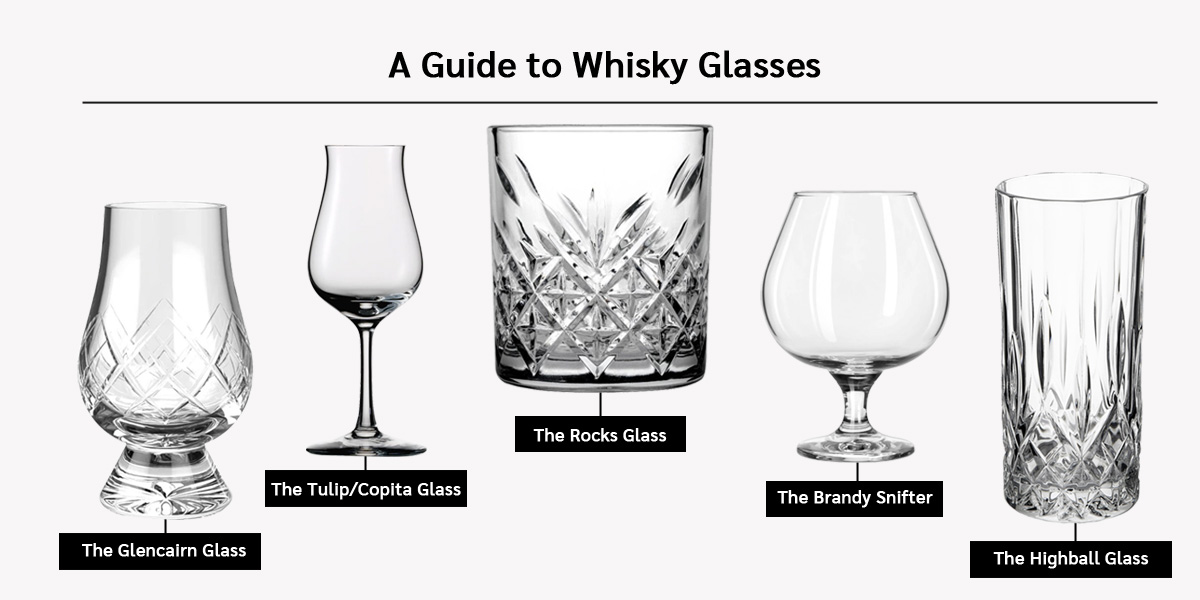
As part of this whisky tasting guide, we suggest using a type of glassware that assists with focusing scents, such as clean Glencairn or tulip-shaped glass. Another great option is the sniffer; similar to Glencairn, it's great for aroma concentration. Moreover, their design makes swirling them a great experience with little leakage risk. As for casual drinking, Highball Glass is perfect for cocktails, while Rocks Glass is fine for a neat or a splash.
The Art of Savoring Whiskey:
See Take a look: Place the glass up to the light to observe the whiskey color. Observe the clarity, brightness, and sharpness. While more intense amber whiskies have been stored for a longer period of time, lighter gold whiskies can be younger. Softly swirl the whiskey around in the glass for evaluation. As the liquid flows down, notice the formation of the "legs" or "tears" on the sides. Thicker whisky legs indicate greater viscosity or a higher alcohol concentration.
Sense of Smell: Gently swirling releases the whiskey's scent. If you want to keep the delicate notes from fading too fast, you should avoid forceful swirling. To take a deep breath in, hold your nose up to the glass and breathe in slowly and on purpose. Pick out distinct scents, such as fruit, spice, caramel, wood, or flowers.
Taste: Take a sip of whiskey and swirl it in your mouth until it reaches every corner. Feel the texture, taste the mouthfeel, and savor the first tastes. Basically, to feel the whisky's aroma, flavor, and texture, hold it in the tongue for a few seconds. Whiskey can stimulate many taste receptors by simply rolling around the tongue. You will notice any change in sweetness, spiciness, bitterness, or flavor.
Finish: Either swallow the whiskey or spit it out; the choice is yours. While swallowing is the preferred method for achieving the full finish, professional tasters often opt for spitting to prevent intoxication. Note what tastes or sensations linger around your mouth after you swallow. Well-aged whiskey would commonly have a full finish with lots of flavors.
Whiskey's Flavor: On the Rocks, Neat, or With a Splash of Water?

Did you know that you could experiment with adding water or ice to whiskey? As water interacts with ethanol molecules, adding a small amount of room-temperature water can actually enhance the flavor. But adding ice could be a double-edged sword. It will chill the whiskey, making it more refreshing, but at the same time, melting ice can dilute the spirit and muffle some of the flavor. So if you want ice, maybe try a large single ice ball; consider slowly melting to fully savor the flavors.
Another thing you can do is taste the whiskey at various temperatures to see how it changes. All the aromas and flavors emerge at room temperature, while the cold temperature muffles them, or the overpowering alcohol burns at high temperatures.
Now that we have come to the end of our blog, always remember that there is no one right way to drink whiskey, but the point is to experiment until you find the perfect blend that appeals to you. Cheers!
Frequently Asked Questions
What is whiskey made from?
Cereal grains such as barley, corn, rye, and wheat are the raw materials used to make whiskey. Barley is the most commonly used grain in the production of most whiskies. But we can also use different blends of grains like corn, rye, and wheat to give the spirit a unique character.
What's the difference between whiskey and whisky?There's no difference; it is just a regional variation in spelling. In the 18th century, the spelling settled on either "whisky" used by Scotland or "whiskey" used in Ireland. There is no change to the taste or the production process itself.
What are the main types of whiskey?The whiskey world offers a wide selection. The major types include Scotch, Irish, Bourbon, Tennessee, Canadian, and Japanese whiskey.
What's the difference between single-malt and blended whiskey?The difference lies in their ingredients and origins. Single malt is 100% malted barley at a single distillery, whereas blended whiskey is a mix of different whiskies.
How is whiskey aged?Wooden casks, primarily charred white oak, age whiskey. It may sit in wooden barrels for anywhere from a few years to several decades. The interactions between the whiskey and the wood in the casks alter its color, flavor, and complexity.
What does "proof" mean on a whiskey bottle?The term "proof" on a whiskey bottle refers to its alcohol content. Essentially, it is twice the volume of alcohol. For example, a 100-proof whiskey contains 50% alcohol.

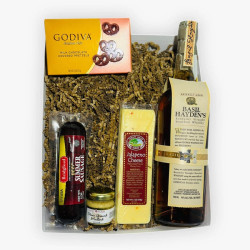
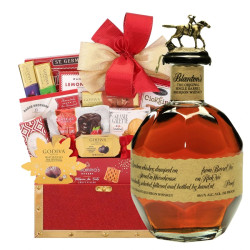
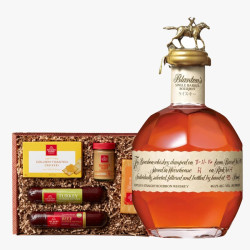
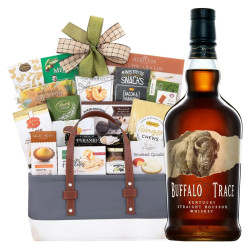
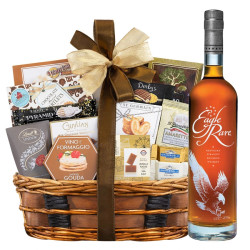

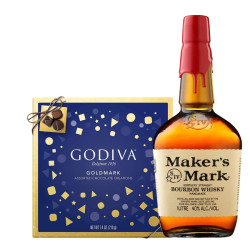
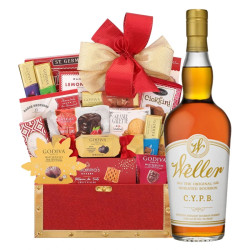













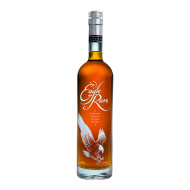
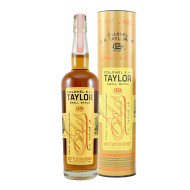
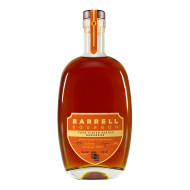


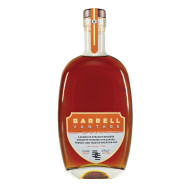
Leave a Comment